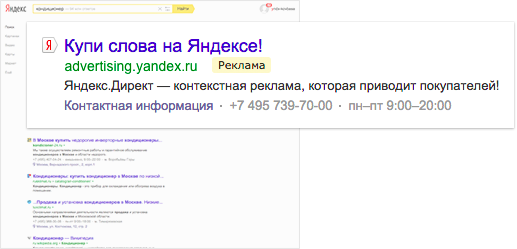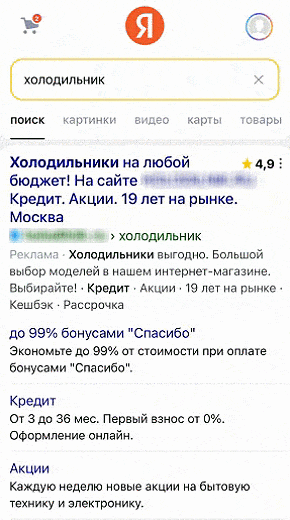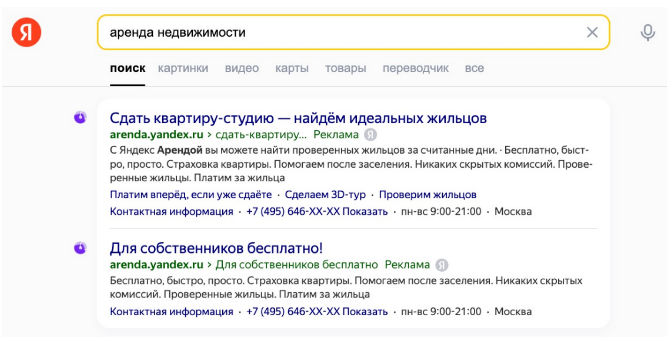Ad placement in search results
Users surf the web for different products and services. Users are shown contextual ads in search results. This type of ads matches exactly the user interests, directly responding to their query with a proper ad offer.
Ads are served on Yandex search results and YAN partner search sites, on desktops, tablets, and smartphones.
Ads are placed in the following sections on Yandex Search results pages:
-
This section is located below the search results. Ads displayed in this section generate the highest number of clicks.

- Remaining impressions
-
Ads that don't get premium placement may be served in the middle or at the bottom of the page.

SERP layouts
To make ads more appealing, Yandex Direct uses SERP layouts, which are different versions of the search results page design with a different layout and format of ad units. Each time a person wants to find a product or service, the algorithm selects the best fitting template and generates ad units for it.
Your traffic volume depends on the template selected and your ad positioning in it. Ads above the search results get more clicks than at the bottom of the page, while the expanded format ads get more clicks than regular ads.
Which template serves the ad
Ads are selected separately for each placement section. They are ranked based on the CPC, quality coefficient, and CTR forecast per impression. The ad with the best combination of indicators gets the placement. In Yandex search results and on YAN search sites, the average CPC is determined based on VCG auction rules.
The more additional elements you add to your ad, the more templates you can access. For example, to be served in expanded format, the ad must contain sitelinks with descriptions.
Yandex Direct continually runs experiments to create more advertising formats. Each new format undergoes several stages of testing and is evaluated by a variety of metrics related to search quality and advertising traffic. To increase the potential reach of your ads, use all the additional elements and choose the optimal bid for your business needs or a suitable automatic strategy. The best placement and display format will be selected for you automatically.
Examples of ad formats in search results
- Regular format
-
Ads are shown with all their extensions (sitelinks, contact information, display link). Callouts are only shown for the ad displayed in the top position.

- Exclusive placement
-
The largest and most noticeable ad format in search results. An exclusive placement ad occupies a single advertising spot above the search results,


- Expanded ad
-
Ad on the first position with sitelinks. Ads of competitors are shown below in the regular format.

Ad with sitelinks. One or more ads can be shown at the same time.

- Ad extension with a promo
-
An ad extension with a promo (a title and a link), callouts, and contact information can appear under the first ad in the premium placement section.
The system selects a SERP layout for each search query based on user preferences. To increase the chances of your ad appearing in the SERP layout, add a promo to it.

- Advertising in suggest
-
The ad appears above the list of suggestions when a user enters a query in the search bar. It's selected algorithmically based on the most likely search suggestion and displayed only if the ad message is highly relevant to the user query. After being shown in suggestions, the ad can also be displayed in the search results.

- Product gallery
-
The product gallery is a carousel with product cards from different stores that appears under the search bar.
For more information, see Product Gallery.

- Mini ad
-
Ad without additional elements (sitelinks, contact information, display link).

- Copying the ad from the top position
-
The ad selected for the top position in the Premium placement section may be also shown at the top of the Remaining positions section.
- Search banners
-
The banner is displayed to the right of search results; as it is the only banner on the page, this draws attention to it. Search banner has a dedicated ad campaign type.

